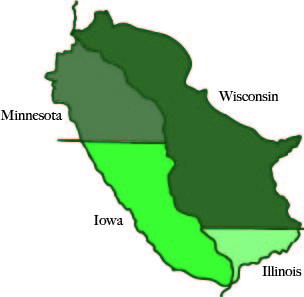Pioneer Talks: Driftless Drug Crisis
The dimensions of drugs in the Driftless and how they can be combated
On March 4, a panel featuring experts from various fields offered insight into the drug crisis that has affected the Driftless Area. The panel was moderated by Bram Sable-Smith, Mike Simonson Memorial investigative reporting fellow for Wisconsin Public Radio. Sable-Smith has extensive experience reporting on health care and has reported on opioid use in rural Wisconsin.
The panel opened with remarks from members of the Grant County Sheriff’s Office. Sheriff Nate Dreckman and Sergeant Mark Schwartz discussed how the opioid epidemic has spread to Southwest Wisconsin.
“The opioid issue and the drug issue in Grant County, in Southwest Wisconsin… it’s probably a little deceiving because I think a lot of us don’t oftentimes think in rural counties that there’s a lot of drug use,” Dreckman said. Dreckman explained that there had been a surge of heroin use in Southwest Wisconsin. After an education campaign on the effects of heroin, there was a dip in heroin use, but there was soon a rise in instances of fentanyl and meth use in the area.
Schwartz, an expert in drug recognition for Grant County, explained how the drug epidemic has evolved and what it looks like in the area. The high prescription rate of pain medication in the 90’s led to an influx of the medication being sold on the street. After prescription rates fell, the dependence on the medications remained, which has morphed into a heroin epidemic.
“On average, people will overdose approximately seven times before they either perish or figure it out, so to speak, and get into treatment,” Schwartz said.
Fred Naatz, director of the Grant County Department of Social Services spoke next on the effect the drug crisis has had on families. Naatz’s department is responsible for removing children from homes that are deemed unsafe. A recent trend showed that of the last 24 cases of a child being removed from a home, meth use was a factor in 18 of those cases. This ratio is a huge increase from what Grant County has seen in the past.
Troy Morris, environmental health coordinator for the Grant County Health Department explained the process of clearing the homes where drugs were found. After a house has been deemed a site of drug use, Morris is contacted to determine what needs to be done before that house can be occupied. Different drugs call for different protocols, with a fentanyl production site costing between 30-35 thousand dollars to be renovated.
Kimberly Hill, director of the Pathways Recovery Program and licensed substance use counselor discussed the development of recovery communities in rural areas. Specifically, Hill has set up a house in Dodgeville for women going through the recovery process. Pathways plans to set up another house in Dodgeville by June 1.
“It’s not a transitional home, you can stay as long as you like,” Hill said. Despite this, most people only stay an average of six to nine months. Hill also emphasized the need for community resources around these homes. Things like medication assistance, job services, human services, a pantry and options for recovery meetings within walking distance are essential for the recovery process.
Clark Thelemann, a social work supervisor for the Grant County Department of Social Services described the cyclical pattern of drug abuse in homes. A series of questions that test for childhood trauma called the Adverse Childhood Experiences (ACE) series has been used to show the effect childhood trauma can have after childhood.
“For example, if you have an ACE score of four plus, you’re five times more likely to have a major depressive disorder. You are 46 times more likely to use IV drugs,” said Thelemann. Meth use has also been shown to increase the likelihood of a larger family. Combined with the increased chance for drug dependence, this creates a cycle that is not only continuous, it is also expanding.
Pioneer Talks is a weekly series occurring every Wednesday at 5:00 p. m. in the Nohr Gallery. Next week’s talk is on March 18 and is titled, “Hydrogeology and Groundwater Quality in Southwestern Wisconsin”.
For more information, visit the Pioneer Talk webpage.




